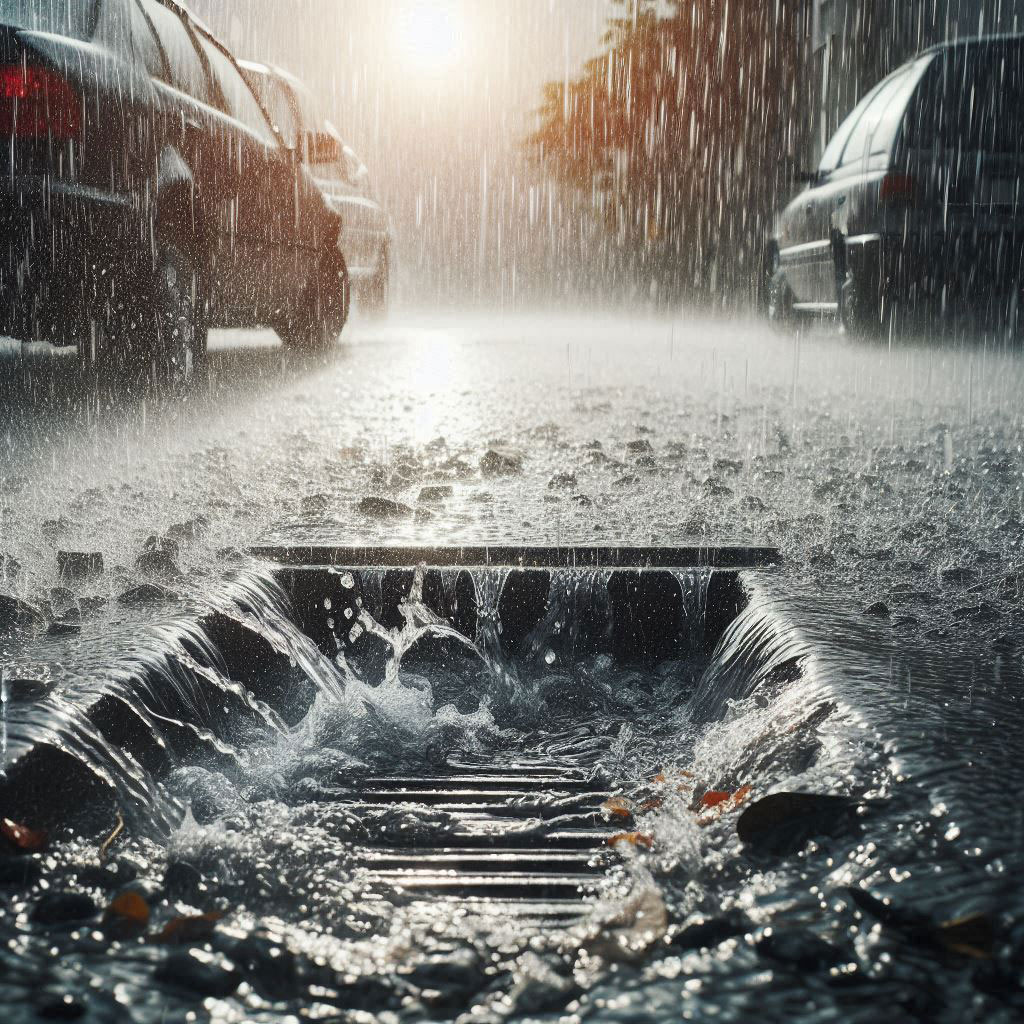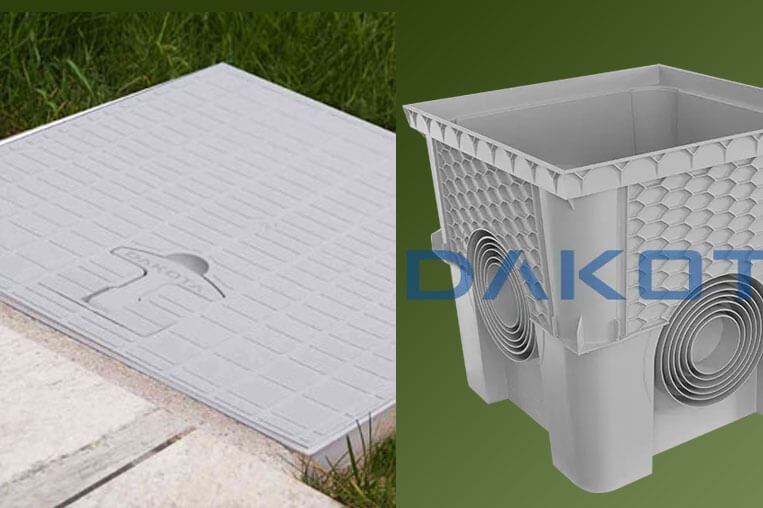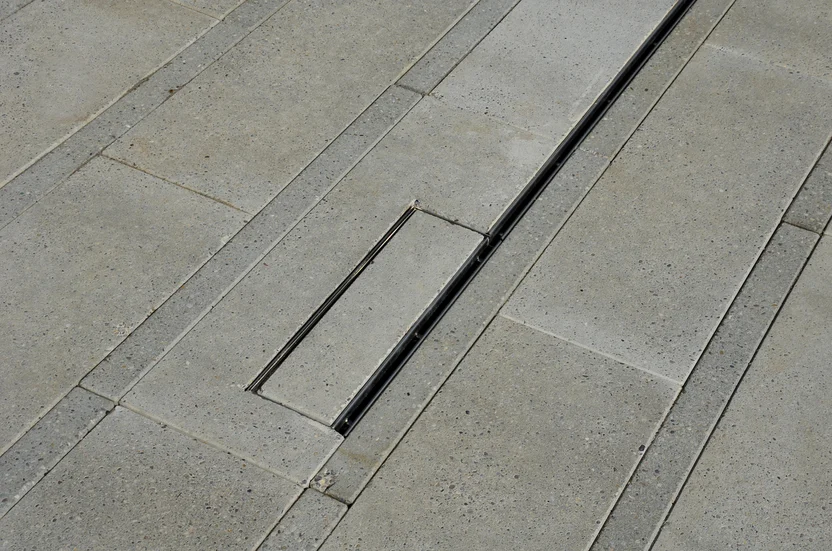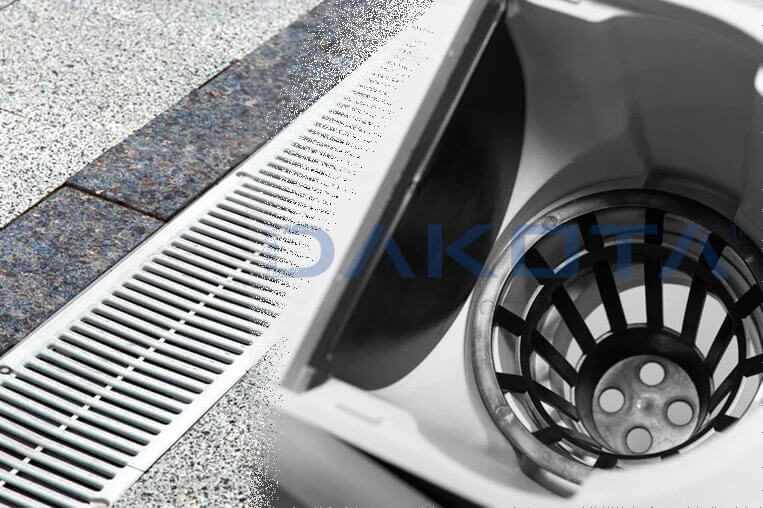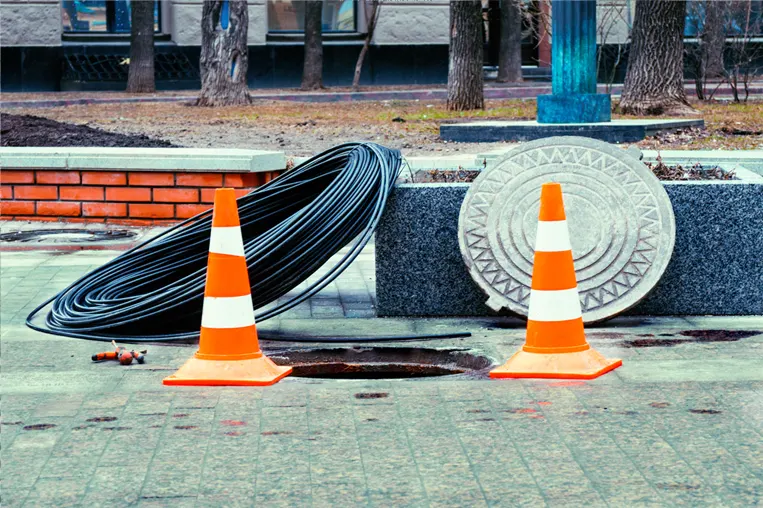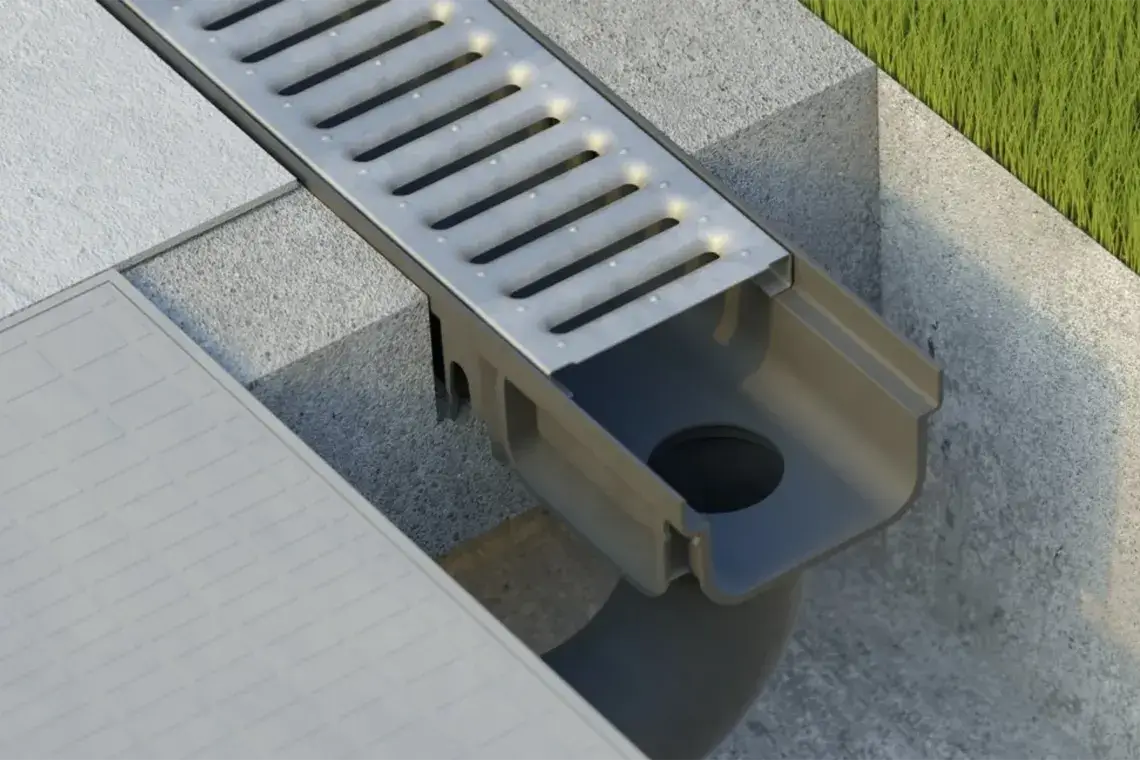Linear slot channels (also called slot drains) represent an innovative and functional solution for the management of rainwater in numerous architectural and urban contexts. In this article we will analyse in detail the advantages and types of use of these particular water conveyance systems.
What is a linear slotted channel
A linear slotted channel is a drainage system surface made up of prefabricated channels, usually in polymer concrete, stainless steel, or plastic materials, equipped with a longitudinal slot for collecting rainwater, which is why they are also identified as linear drains.
The different elements that make up the channel (bottom, walls, grid) are modular and fit together perfectly during installation. Their covering grid has a linear slot for water to flow into, while retaining debris and foreign bodies.
This particular type of channel differs from traditional drainage systems with open gratings, instead using a longitudinal slot which guarantees aesthetic continuity with the surrounding flooring making the system almost invisible. It is used for the conveyance of rainwater.
Advantages of linear slot channels
The use of linear slot channels is growing constantly thanks to the numerous advantages that these systems offer:
- Aesthetic discretion. The longitudinal slot guarantees a minimal visual impact and perfect integration with surrounding flooring.
- Adaptability. The different modular components allow you to create tailor-made and personalised configurations for each application.
- Easy installation. The interlocking system of the various elements simplifies installation.
- Efficient drainage. The longitudinal slot guarantees excellent flow and conveyance of rainwater.
- Cleaning and maintenance. The channels are easily inspected and cleaned.
- Strength and durability. Made of highly resistant materials they guarantee excellent performance over time.
Aesthetic appearance of slotted drains
One of the main advantages of slot channels is the exceptional aesthetic appearance. Unlike traditional drains and drainage systems, the longitudinal slot guarantees a minimal effect and perfect integration with the surrounding flooring, making it almost invisible.
This makes them the ideal solution in all those architectural and urban contexts where you want to combine functional efficiency and aesthetic cleanliness - historic urban settings, pedestrian centres, residential areas, car parks, terraces and balconies, just to name a few examples.
Adaptability of linear drains
The modularity of the system allows you to combine different channel configurations and grates for rainwater drainage with the slot drains, thus allowing for solutions to meet specific design and environmental needs.
The range of sizes available allows you to select the right capacity channels depending on the volume of rainwater to be disposed of. In addition, the possibility of taking into account the flow rates based on actual slopes and dimensions, allows them to be harmoniously integrated into any context.
Quick installation of linear slot channels
The interlocking system of the various standardised components facilitates and speeds up the installation of the linear slot channels, reducing installation times and costs.
The modular elements are simply placed next to each other and locked together with special spacers and fastening devices.
Drainage efficiency of slot channels
The longitudinal slot guarantees excellent conveyance of rainwater from the collection and removal points. The channel shape of the system ensures that the water flows quickly inside it, avoiding stagnation on surrounding floors and facilitating the drainage of surface water.
Furthermore, the possibility of being installed with adequate longitudinal and transversal slopes ensures the disposal of even intense rainfall.
Easy cleaning and maintenance of slot channels
The shape of the slot channels allows for easy inspection and cleaning. The use of removable inspection seals allows the verification of the internal cleanliness of the entire system and allows the possibility of carrying out any required maintenance operations.
Additionally, most foreign bodies and debris are retained by the grate, preventing them from entering the channel and accumulating within the drainage system.
Excellent strength and durability for linear slot channels
When made with high-resistance materials, such as PP (polypropylene) or PE-HD (high density polyethylene), linear slot channels guarantee high performance in terms of mechanical resistance, corrosion resistance and durability over time.
This also makes them suitable for uses in areas subject to heavy loads such as industrial areas, ports and airports. Furthermore, if adequately sized, some models can withstand the transit of vehicles.
Types of use of slot channels
Linear slot channels are used in numerous settings, both in the residential and commercial sectors.
Let's briefly analyse some of the main applications.
Pedestrian areas and historic centres - The aesthetic integration with the flooring and the absence of visible grills and drains make them the ideal choice for managing rainwater in pedestrian areas, historic centres, courtyards, cloisters and wherever you want to combine hydraulic efficiency and formal clean design lines.
Parking lots and garages - Installed along the manoeuvring lanes, slot channels collect and quickly convey rainwater, avoiding stagnation and puddles inside car parks, garages, access ramps to basements and garages.
Terraces, flat roofs and balconies - Linear slot channels are the ideal solution for efficient and, at the same time, discreet linear drainage of terraces, flat roofs, balconies and loggias of residential and non-residential buildings.
Swimming pools - Around the edges of the pool or along the walkways, slot channels collect excess water coming from the pool, quickly conveying it towards the water drainage networks.
Industrial and commercial buildings - The high performance in terms of flow rate and mechanical resistance make linear slot channels ideal for managing large volumes of rainwater in industrial buildings, logistics warehouses, shopping centres and supermarkets.
Airports - Compliance with the heaviest load classes makes slot channels an ideal solution for rainwater drainage in airport parking and manoeuvring areas.
Ports and docks - Linear slot channels can be used in all port areas subject to the passage of particularly heavy loads such as docks and docking piers.
Design and regulatory requirements for slot channels
For optimal use of linear slot channels, it is important to know their technical and performance characteristics, as well as the regulatory requirements to be respected during the sizing and installation phase.
Load classes of slot drainage channels
DIN19580 / EN 1433 is the only recognised international standard written specifically for Channel / Trench Drains. It is also widely accepted in the United States and worldwide as the benchmark. Dakota drainage channels are manufactured to meet or exceed the required standards.
The standard applies to both pedestrian and vehicular areas to ensure the creation of correctly specified surface water drainage systems.
Grate Design Load of at least:
CLASS A 15
15 kN / 3,372 lbs. load test = 1.5 metric ton / 1.65 US tons
Group 1: Areas that can be used only by pedestrians and cyclists.
CLASS B 125
125 kN / 28,100 lbs. load test = 12.5 metric tons / 13.7 US tons
Group 2: Sidewalks, pedestrian areas and comparable areas, parking for private cars or multilevel car parks.
CLASS C 250
250 kN / 56,200 lbs. load test = 25 metric tons / 27.5 US tons
Group 3: Road curbs and areas not directly exposed to vehicle traffic or similar; commercial parking lots and general commercial areas.
CLASS D 400
400 kN / 89,920 lbs. load test = metric 40 tons / 44 US tons
Group 4: Roads with heavy traffic (including pedestrian streets) and parking areas for all types of road vehicles.
CLASS E 600
600 kN / 134,800 lbs. load test = metric 60 tons / 66 US tons
Group 5: Areas subjected to extremely heavy vehicles traffic, e.g. fuel stations, industrial and warehouse roadways and loading bays, etc.
CLASS F 900
900 kN / 202,320 lbs. load test = metric 90 tons / 99 US tons
Group 6: Areas subjected to very high wheel loads, for example docks and airports.
It is essential to choose the most suitable load class based on the expected traffic and load conditions. For example, for pedestrian areas, class B125 is sufficient, while for airports and port quays, class F900 is necessary.
CE marking of linear channels
Pursuant to EU Regulation 305/2011, manufacturers of linear channels must guarantee compliance with the harmonised standard UNI EN 1433 affixed through the CE marking on the products.
Slopes and sizing of the linear drainage system
To ensure adequate flow, the longitudinal slope can be between 0.5 and 1.5 %. Transverse slopes must not exceed 5%.
The sizing of the channel must take into account the maximum rain flow rate calculated, based on local intense rainfall historic figures and the area and type of the collection surfaces surrounding the installation.
Linear drainage system fire regulations
If the channels are intended for the disposal of rainwater coming from escape routes of buildings, they must comply with the requirements of the fire prevention regulations (DM 3/8/2015).
Materials and finishes of linear slot channels
Linear slot channels can be made with different materials and finishes to best integrate with the surrounding environment.
Slotted channels in polymer concrete - This is the most widespread material used thanks to its high mechanical and atmospheric agent resistance. The finishes of the slot channels made with this material can be smooth, ashlar or with a stone covering.
Stainless steel slot channels - Guarantee very high performance in terms of corrosion resistance. Slot channels in AISI 304 stainless steel can have various finishes: satin, matt or glossy.
Slot channels in ductile cast iron - Guarantee excellent resistance to loads even in the most demanding environments. The surface of the linear slot channels made of ductile cast iron can have metallic finishes or stone coverings.
Copper slot channels - Offer a high aesthetic value as well as excellent corrosion resistance qualities. The finishes of the linear copper channels can be natural or pre-oxidized.
Natural stone slot channel - Give a high aesthetic value in prestigious contexts. The most used materials for linear slot channels in natural stone are granite, basalt and local stones.
Slotted channel in Corten steel - Corten steel gives a characteristic rust effect with shades that range from dark brown to orange. The linear drainage channels made of Corten steel also offer excellent resistance.
Linear slot channels made of plastic materials - Plastic materials, dedicated to the creation of linear slot channels, offer all the advantages of the previously mentioned materials, but they are cheaper and easier to install, they adapt better to various applications, and allow less friction to the flow of water thanks to their smooth and non-porous surface.
Installation of linear slot channels
Let's briefly consider the main phases for correct installation of linear slot channels.
Excavation and preparation of the laying surface - Start by making a special excavation to house the channels. The bottom must be compacted and carefully levelled according to the established slopes.
Laying drainage channels - The channels are placed on the carefully levelled bottom of the excavation. The different elements are joined using the appropriate joining devices.
Transverse slope - Any spacer elements allow you to set the necessary transversal slope.
Filling and compaction - The excavation is filled with suitable materials (sand or gravel) suitably compacted around the channels.
Connection to the disposal system - The channels are connected to the rainwater disposal system (sewer, lamination tank, etc.).
Laying the grid - The slotted grid is finally positioned on the channels and locked using the appropriate fastening devices.
Removing the slotted grids for maintenance - For inspection and cleaning of the system, the slotted grids can be quickly removed by releasing the locking devices.
Maintenance of linear slot channels
To maintain the efficiency of the drainage system over time, it is important to carry out correct periodic maintenance of the linear slot channels.
Surface cleaning - Elimination of debris, leaves and dirt that could block the slotted grid, preventing the water from flowing.
Removing and cleaning the slotted grid - Removal of the grate and removal of debris accumulated inside it to restore full drainage capacity.
Cleaning of drainage channels - Remove sediments and obstructions that may have accumulated at the bottom of drainage channels using water jets or purging systems.
Slope control - Check the longitudinal and transversal slopes to ensure that they still allow correct flow of rainwater.
Inspection of slotted channel joints - Checking the junction devices between the different elements to verify that they are still intact and functional.
Checking the slotted channel supports - Inspection of any supports that support the channels in case of overhead installation.
Replacement of damaged elements - Seriously damaged channel elements must be removed and replaced with intact components.
Correct periodic maintenance allows you to prevent malfunctions and optimise the efficiency of the drainage system over time.
Advantages of slot channels compared to traditional drainage systems
As we have already seen, linear slot channels offer various advantages compared to traditional drainage systems such as drains. We summarise the main ones here:
- Greater aesthetic discretion
- Integration with the surrounding flooring
- Absence of visible grates and drains
- Easy installation and possibility of customised configurations
- Excellent continuous drainage along the entire length
- Less tendency to blockage from debris
- Greater ease of inspection and cleaning
- Possibility of transit (for some models)
- Suitable for both public and residential contexts
Conclusions
Linear slot channels represent an innovative and high-performance solution for the drainage and collection of rainwater in numerous architectural and urban contexts.
Thanks to their high performance and compliance with sector technical regulations, slot channels represent the ideal solution for the sustainable management of rainwater in compliance with the best technical, functional and aesthetic standards.

